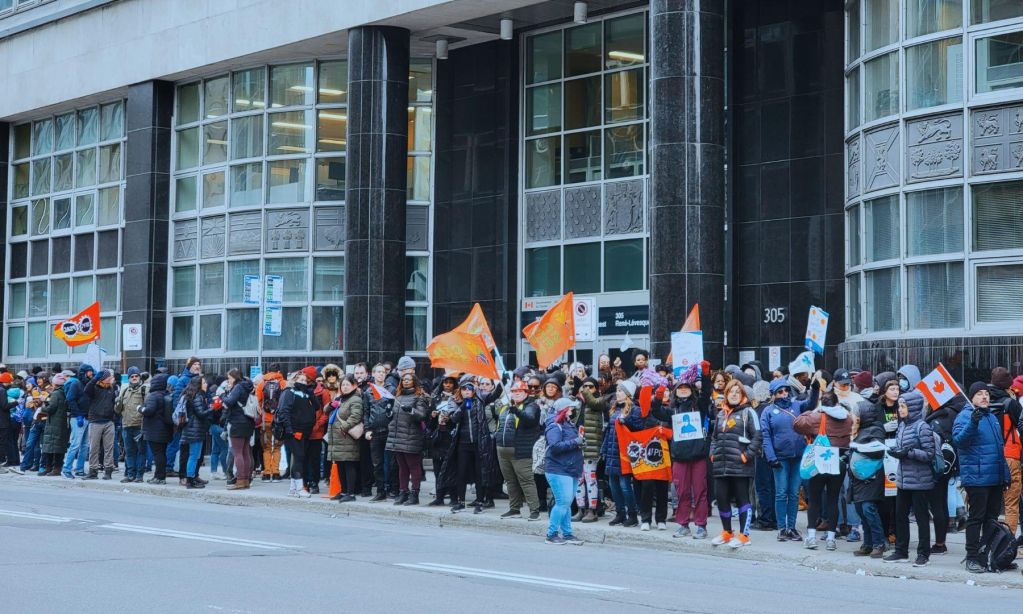Unions are having an inspiring moment of increased power and influence. In North America, workers are making organizing breakthroughs at Starbucks, Amazon, and other companies that have long busted union drives. Since 2022, strikes have surged in public schools and universities, the civil service, public utilities, shipping, transportation and logistics, manufacturing, journalism, and even in Hollywood.
Workers are showing renewed confidence and commitment to fight for better wages and working conditions. They are taking strike votes with strong majorities and bargaining to the eleventh hour. They are turning down tentative agreements that even two years ago would have been considered good (or good enough). They are winning strikes and achieving life-changing improvements. How do we understand this groundswell of workers exerting their economic power? Is this upsurge here to stay? Where might it lead?
The COVID-19 pandemic created a perfect storm of conditions that increased worker frustration. For many, the initial experience of mass unemployment was disorienting, but so too was the need to continue working in pandemic conditions to deliver essential public and private services. The celebration of healthcare and grocery store workers as “heroes”—expressed through pandemic pay—soon soured as employers clawed back those premiums. Employers intensified work without additional compensation—and treated workers as a means to an end, asking them to put the greater good ahead of their health and wellbeing. Add to this the reality of so much personal loss, death and illness. As a result, many people’s attitudes towards their jobs and employers have changed.
As shuttered workplaces reopened and returned to what some called “normal”, the pandemic’s ongoing disruptions have made it more possible for workers to express their frustration effectively through collective action. Workers have more bargaining leverage than they’ve had in decades. The high demand for labour has lowered unemployment and made it harder to replace workers. It’s been decades since we’ve seen labour market conditions like these.
High inflation is also pushing workers’ militancy. The cost-of-living crisis, especially in food, energy, and housing, has made it impossible for workers to keep up based on the one or two per cent wage increases that have become typical since the 1990s.
Some governments’ explicit attempts to repress public sector wages worsened the situation. In Ontario, since 2019, the Ford government’s Bill 124 limited Ontario’s public sector workers to one per cent per year for a three-year period, eroding their real wages and putting them even further behind when inflation began to rise in 2021. Since deemed unconstitutional, Bill 124 has fuelled a wave of catch-up negotiations and strikes. Grocery store and school board workers, who have long had to work multiple jobs and use food banks to survive, expressed the urgency to make gains in the form of strikes. But even relatively well-paid workers are finding it harder to make ends meet. This shared experience of inflation eroding wages has created the basis for more widespread worker solidarity than we’ve seen for some time.
Record profits have also thrown fuel on this fire. Whether grocery store chains, BC port employers, or the Detroit Big Three, it’s clear that employers and shareholders have taken advantage of the pandemic and its aftermath to drive up prices and make windfall profits. Readers of the CCPA’s research will well know that income inequality has been increasing unabated for years, with CEOs capturing most of the income growth generated by workers’ efforts. However, the unequal experience of sacrifice and effort during the pandemic seems to have changed people’s tolerance for this situation, and the economic conditions are allowing them to push back.
The public has met the recent wave of high-profile strikes with strong support for workers. Polling on the spring 2023 federal government workers’ strike showed majority support for many of the workers’ key issues, including on wages. Support was even stronger for Ontario’s education workers in fall 2022—nearly 50 per cent said they supported other unions walking out to defend CUPE’s right to bargain.
US workers facing down their employers are backed by an average of 70 per cent of Americans who side with the United Auto Workers, the Writers’ Guild of America and SAG-AFTRA rather than their employers. On the issue of strikes versus “the economy,” an Angus Reid poll issued September 1 shows that 47 per cent of Canadians believe that the right to negotiate better working conditions is more important than the economic disruption or damage to Canada’s economy, while only 37 per cent put “the economy” ahead of workers’ rights. Perhaps this reflects a growing understanding that “the economy” can’t be healthy without protecting workers’ real wages and livelihoods.
Of course, unions and workers still face real challenges. The spate of strikes we’ve been seeing hasn’t brought Canada’s strike rate up to its recent peak of 4 million person-days not worked in 2004, let alone its historic high in 1976, 11.5 million person-days not worked. Anti-union governments, especially at the provincial level, continue to undermine workers’ rights and unions’ effectiveness.
Alberta’s Bill 32 requires union members to opt into the portion their dues going to “political activities, social causes, charities, non-governmental organizations, or organizations supportive of a political party” and makes a false distinction between the “core” economic function of unions and their political and social role. The threat of governments’ use of back-to-work legislation to restrict workers’ leverage also still looms large in many unionists’ minds, lowering their expectations and undermining their confidence in strike action.
It’s also not clear how much longer this window of opportunity for unions will remain open. Policy makers are working to control inflation by deflating the economy through higher interest rates. Statistics Canada reported on September 1 a slight contraction in economic growth in the second quarter of 2023, signalling that this deflationary policy may be having an effect. The federal government has also widened employers’ access to workers through the Temporary Foreign Worker Program. Employers have grown used to having the upper hand in the labour market and using the threat of job loss to discipline workers and lower their expectations. The pressure they are placing on governments to return to those conditions is immense.
That said, there are many reasons for longer-term optimism. Thousands of workers—many for the first time in their lives—have been on strike and have won, an empowering experience that generates lifelong commitments to unionism and inspires others to fight. Many more workers, like Unifor members at Ford, GM and Stellantis, have taken historic strike votes to strengthen their hand in bargaining. And demographic shifts may also be on the labour movement’s side. As the baby boomer generation retires, they are being replaced by Gen Z workers whose support for unionization and for strikes is much stronger, as the Angus Reid poll also clearly shows.
This is another urgent signal to the labour movement to turn this strike wave into an organizing wave while we can. That means the time for unions to act is now.







